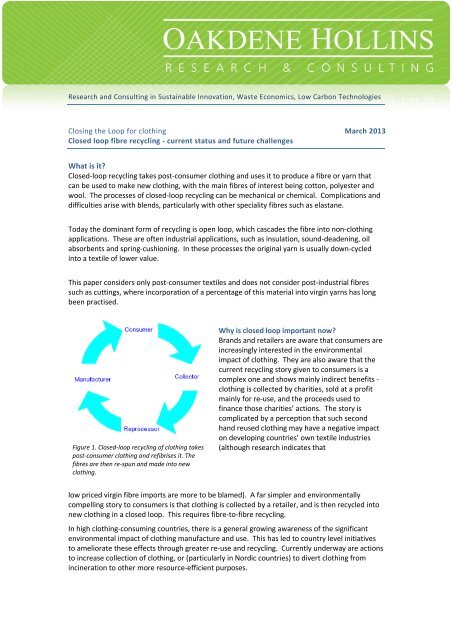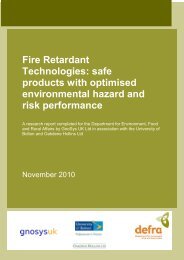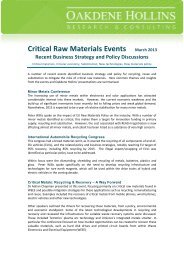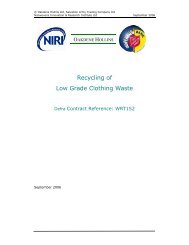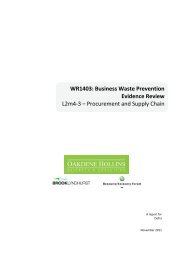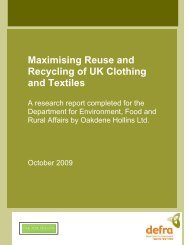Closing the Loop for clothing - Oakdene Hollins
Closing the Loop for clothing - Oakdene Hollins
Closing the Loop for clothing - Oakdene Hollins
You also want an ePaper? Increase the reach of your titles
YUMPU automatically turns print PDFs into web optimized ePapers that Google loves.
Research and Consulting in Sustainable Innovation, Waste Economics, Low Carbon Technologies<br />
<strong>Closing</strong> <strong>the</strong> <strong>Loop</strong> <strong>for</strong> <strong>clothing</strong> March 2013<br />
Closed loop fibre recycling - current status and future challenges<br />
What is it<br />
Closed-loop recycling takes post-consumer <strong>clothing</strong> and uses it to produce a fibre or yarn that<br />
can be used to make new <strong>clothing</strong>, with <strong>the</strong> main fibres of interest being cotton, polyester and<br />
wool. The processes of closed-loop recycling can be mechanical or chemical. Complications and<br />
difficulties arise with blends, particularly with o<strong>the</strong>r speciality fibres such as elastane.<br />
Today <strong>the</strong> dominant <strong>for</strong>m of recycling is open loop, which cascades <strong>the</strong> fibre into non-<strong>clothing</strong><br />
applications. These are often industrial applications, such as insulation, sound-deadening, oil<br />
absorbents and spring-cushioning. In <strong>the</strong>se processes <strong>the</strong> original yarn is usually down-cycled<br />
into a textile of lower value.<br />
This paper considers only post-consumer textiles and does not consider post-industrial fibres<br />
such as cuttings, where incorporation of a percentage of this material into virgin yarns has long<br />
been practised.<br />
Figure 1. Closed-loop recycling of <strong>clothing</strong> takes<br />
post-consumer <strong>clothing</strong> and refibrises it. The<br />
fibres are <strong>the</strong>n re-spun and made into new<br />
<strong>clothing</strong>.<br />
Why is closed loop important now<br />
Brands and retailers are aware that consumers are<br />
increasingly interested in <strong>the</strong> environmental<br />
impact of <strong>clothing</strong>. They are also aware that <strong>the</strong><br />
current recycling story given to consumers is a<br />
complex one and shows mainly indirect benefits -<br />
<strong>clothing</strong> is collected by charities, sold at a profit<br />
mainly <strong>for</strong> re-use, and <strong>the</strong> proceeds used to<br />
finance those charities’ actions. The story is<br />
complicated by a perception that such second<br />
hand reused <strong>clothing</strong> may have a negative impact<br />
on developing countries’ own textile industries<br />
(although research indicates that<br />
low priced virgin fibre imports are more to be blamed). A far simpler and environmentally<br />
compelling story to consumers is that <strong>clothing</strong> is collected by a retailer, and is <strong>the</strong>n recycled into<br />
new <strong>clothing</strong> in a closed loop. This requires fibre-to-fibre recycling.<br />
In high <strong>clothing</strong>-consuming countries, <strong>the</strong>re is a general growing awareness of <strong>the</strong> significant<br />
environmental impact of <strong>clothing</strong> manufacture and use. This has led to country level initiatives<br />
to ameliorate <strong>the</strong>se effects through greater re-use and recycling. Currently underway are actions<br />
to increase collection of <strong>clothing</strong>, or (particularly in Nordic countries) to divert <strong>clothing</strong> from<br />
incineration to o<strong>the</strong>r more resource-efficient purposes.
Ano<strong>the</strong>r reason <strong>for</strong> <strong>the</strong> current emphasis on closed-loop is <strong>the</strong> likely increase in <strong>the</strong> quantities of<br />
re-use/recycling grade <strong>clothing</strong> collected. Although consumers in many countries are familiar<br />
with <strong>clothing</strong> collections operated (usually) by companies controlled by charities, currently<br />
disposal is often only of <strong>clothing</strong> that <strong>the</strong> consumer considers suitable <strong>for</strong> reuse 1 . However, we<br />
expect a gradual increase in <strong>the</strong> proportion of re-use and recycling grades of <strong>clothing</strong> as<br />
collection rates increase through a combination of factors including greater consumer awareness<br />
and greater opportunity, such as M&S Schwopping and H&M’s in-store collection arrangements<br />
with I:Co. As <strong>clothing</strong> collection increases, it is reasonable to expect that <strong>the</strong> quality of <strong>the</strong><br />
<strong>clothing</strong> will decrease, as consumers send <strong>for</strong> re-use or recycling <strong>clothing</strong> that <strong>the</strong>y would<br />
o<strong>the</strong>rwise have disposed of in municipal waste.<br />
Lastly, closing material loops has been given high profile through <strong>the</strong> actions of <strong>the</strong> Ellen<br />
McArthur Foundation (at a policy level) and <strong>the</strong> Cradle to Cradle approach (at a design level).<br />
Economics<br />
Financially speaking, from <strong>the</strong> perspective of a textile collection and sorting operation, recycling<br />
of <strong>clothing</strong> is much less attractive than re-use. The price of recycling grades obtained by textile<br />
sorters is usually less than <strong>the</strong> cost of <strong>the</strong> collection and sorting, but obviously better than paying<br />
<strong>for</strong> disposal, which is <strong>the</strong> only o<strong>the</strong>r option. Hence recycling is cross-subsidised by <strong>the</strong> higher<br />
prices obtained from <strong>the</strong> sale of garments <strong>for</strong> re-use.<br />
Figure 2. Shoddy production, India (Photo: Tim<br />
Mitchell)<br />
The perspective of organisations using<br />
recycled textiles is different. In developed<br />
countries most recycled fibre is sent to openloop<br />
recycling into industrial products such as<br />
mattress flocking or automotive sound<br />
deadening. Prices of <strong>the</strong>se products are highly<br />
competitive and <strong>the</strong> manufacturers rely upon<br />
cost-effective recycled raw materials to give<br />
<strong>the</strong>m an advantage over virgin raw materials<br />
which may have superior per<strong>for</strong>mance or<br />
appearance. There is potential <strong>for</strong> more<br />
recycled fibre to be absorbed by <strong>the</strong>se<br />
applications, but only at <strong>the</strong> right price. In<br />
early 2013 in <strong>the</strong> UK this means below £100<br />
per tonne.<br />
Closed loop recycling methods are already available <strong>for</strong> some textiles and depend on <strong>the</strong> fibre<br />
type and <strong>the</strong> end product. Technologically mature processes such as shoddy production in India,<br />
Morocco or Tunisia recycle used garments, while technologically advanced methods such as<br />
Teijin’s or Toray’s polyester recycling use chemical recycling to produce new yarns. There are<br />
also o<strong>the</strong>r processes under development, particularly <strong>for</strong> fibre mixes.<br />
1 See “Public Understanding of Sustainable Clothing” Research Report <strong>for</strong> Defra No. EV0405, 2008
History<br />
Closed loop recycling of <strong>clothing</strong> pre-dates<br />
<strong>the</strong> industrial open-loop applications that<br />
now dominate. Wool has historically been<br />
<strong>the</strong> most recycled fibre, partly due to its<br />
previously high market share in <strong>clothing</strong>,<br />
and partly <strong>the</strong> greater ease of fibrising <strong>the</strong><br />
knitted products in which woollens have<br />
tended to predominate. The UK West<br />
Yorkshire woollen industry actually used<br />
around 40% recovered wool at its height,<br />
with shoddy mills manufacturing a lower<br />
quality cloth often used in workwear or in carpet underlay.<br />
In Sweden Stena Recycling employed over 100 people in <strong>the</strong> fibrising of cloth, to be re-spun and made<br />
into blankets or o<strong>the</strong>r products. All of <strong>the</strong>se operations disappeared over 20 years ago due to reduced<br />
demand and lack of competitiveness. The industry now resides primarily in India, but also in some North<br />
African countries, with blankets <strong>the</strong> main product. These may be low quality emergency blankets <strong>for</strong><br />
relief operations, or more stylish patterned blankets of greater value.<br />
Some small scale fibrising and res-pinning of yarn still exists in Europe. In Prato, Italy, <strong>the</strong>re is a network<br />
of companies that use <strong>the</strong> post-industrial cuttings from primary <strong>clothing</strong> manufacture, toge<strong>the</strong>r with<br />
some <strong>clothing</strong>, to re-spin yarn. Usually this is from worsted or woollen <strong>clothing</strong>. There exist o<strong>the</strong>r<br />
isolated examples of small companies carrying out respinning in Europe.<br />
Little historical evidence exists <strong>for</strong> closed loop chemical recycling of cellulosics, although cotton linters<br />
(byproducts of cotton ginning) are used in <strong>the</strong> production of cuproammonium rayon.<br />
Chemical recycling of polyester per se has been long known and a number of possible routes exist.<br />
Chemical recycling of polyester <strong>clothing</strong> was established commercially around five years ago in Japan by<br />
Teijin.<br />
Current state of play<br />
Mechanically recycled fibre from post-consumer <strong>clothing</strong> is being used in a range of small scale initiatives.<br />
For example, a coat recently launched by M&S contains fibre from “schwopped” <strong>clothing</strong> collected in<br />
M&S stores. 2 The Dutch Jeans <strong>for</strong> Jeans 3 project was able to incorporate a percentage of recycled denim<br />
from <strong>clothing</strong> into new denim yarn.<br />
A number of corporate <strong>clothing</strong> projects have created new <strong>clothing</strong> such as hoodies or scarves from used<br />
uni<strong>for</strong>ms. In this case, <strong>the</strong> fibre mix is often polyester-wool. Although not <strong>clothing</strong>, <strong>the</strong>re have also been<br />
a number of projects producing bags and similar accessories from corporate <strong>clothing</strong> 4 .<br />
The supply chain <strong>for</strong> <strong>the</strong>se products is often small scale involving pulling and re-spinning operators<br />
working on intermittent or one-off projects. Working at a small scale with modest machinery sizes<br />
and/or slower speeds can help to retain fibre length and improve <strong>the</strong> quality of <strong>the</strong> product compared to<br />
<strong>the</strong> fibre obtained from machines set up to produce large volumes of non-wovens <strong>for</strong> industrial<br />
2 http://social.marksandspencer.com/fashion-2/sustainable-fashion-<strong>the</strong>-shwop-coat/<br />
3 http://kici.nl/en/innovate/non-wearable-textiles/recycled-jeans<br />
4 http://www.wornagain.co.uk/blogs/media
applications. Even so, <strong>the</strong>re is often a degree of quality reduction in <strong>the</strong> re-spun yarn, hence <strong>the</strong> use in<br />
scarves and coats using weave patterns where small imperfections may be more successfully hidden.<br />
Chemical recycling<br />
In chemical recycling of polyesters, Teijin have successfully extended <strong>the</strong>ir Eco Circle scheme to over 100<br />
customers in Japan, mainly corporate <strong>clothing</strong> suppliers, who send uni<strong>for</strong>ms <strong>for</strong> recycling and receive<br />
back Teijin fibre <strong>for</strong> fur<strong>the</strong>r use. The company has now established a joint venture with Jinggong Holding<br />
Group to establish polyester recycling in China using Teijin’s process, so fur<strong>the</strong>r growth is expected in <strong>the</strong><br />
Far East of this business model. In addition o<strong>the</strong>r Far Eastern polyester manufacturers such as Toray are<br />
developing competitive recycling processes. Some work is also occurring in Western Europe, although<br />
this is currently only at <strong>the</strong> laboratory scale.<br />
Cellulosic recycling is still at <strong>the</strong> developmental stage, with R&D projects at Manchester University,<br />
Renewcell 5 , Chalmers University 6 and Saxion University aiming to recycle used cotton <strong>clothing</strong> into ei<strong>the</strong>r<br />
a chemically modified (e.g. viscose) or pure cellulosic (e.g. lyocell) fibre. These projects are mostly based<br />
on pulping of <strong>the</strong> cotton and its dissolution in solvents associated with <strong>the</strong>se fibres. The Chalmers project<br />
will also consider <strong>the</strong> recycling of polycotton blends through <strong>the</strong> recycling of <strong>the</strong> polyester component.<br />
O<strong>the</strong>r parts of <strong>the</strong> recycling supply chain are gearing up <strong>for</strong> fibre recycling. For example, <strong>the</strong><br />
Textiles4Textiles project has developed a machine which sorts used <strong>clothing</strong> according to composition.<br />
This will be able to feed recycling processes <strong>for</strong> specific fibre types ra<strong>the</strong>r than end-use applications, as is<br />
<strong>the</strong> case at present.<br />
The Future<br />
The volumes of <strong>clothing</strong> collected <strong>for</strong> re-use and recycling across Europe are likely to increase due a<br />
number of factors:<br />
<br />
<br />
<br />
<br />
Continuing high prices <strong>for</strong> used <strong>clothing</strong>, in turn driven by steady demand from outside <strong>the</strong> EU (and<br />
<strong>for</strong> <strong>the</strong> best quality <strong>clothing</strong>, within <strong>the</strong> EU)<br />
Possible landfill ban extensions<br />
Possible extension of producer responsibility and a drive towards recycling away from energy<br />
recovery in Nordic countries<br />
Increasing collection rates of <strong>clothing</strong> from government and retailer initiatives such as Schwopping,<br />
H&M/I:Co, Jack Jones/I:Co and Puma in-store collection.<br />
As collection rates increase, so <strong>the</strong> percentage of lower grade <strong>clothing</strong> only suitable <strong>for</strong> recycling will also<br />
increase, since it is known that consumers are more likely to treat as rubbish <strong>clothing</strong> that <strong>the</strong>y would not<br />
wear <strong>the</strong>mselves. The rate of increase may only be slow, since countries with high collection rates such<br />
as Germany appear to have retained high levels of re-use. The retailers and brands involved in in-store<br />
collection are keen to make new <strong>clothing</strong> from old, in order to communicate a much simpler<br />
environmental message than <strong>the</strong> current recycling model, which is driven by financial advantage to a<br />
charity (although not wishing ei<strong>the</strong>r to disadvantage charities who currently benefit).<br />
The challenges to closed loop recycling are substantial. Mechanical recycling faces <strong>the</strong> problem of colour<br />
and fibre segregation currently only addressed by <strong>the</strong> (offshore) shoddy industry. In addition <strong>the</strong> suitable<br />
scale of processing in <strong>clothing</strong> is not high enough <strong>for</strong> volume recycling. Higher percentages of recycled<br />
fibre might also lead to consumer resistance owing to perceptions of reprocessed fibres being unclean.<br />
We <strong>for</strong>esee mechanical fibre-to-fibre recycling continuing to be a niche sector, with limited projects in<br />
corporate <strong>clothing</strong> recycling and also taking a small proportion of <strong>the</strong> market <strong>for</strong> larger <strong>clothing</strong> areas<br />
5 http://renewcell.se/hem/<strong>the</strong>-process.html<br />
6 http://www.mistrafuturefashion.com/en/research_program/project5/Sidor/default.aspx
such as denim. Useful projects can be carried out to bring toge<strong>the</strong>r small fibrisers and spinners to create<br />
a more integrated offering to retailers and brands <strong>for</strong> a wider range of products.<br />
We are optimistic that <strong>the</strong> development issues in cellulosic fibre recycling will be solved with <strong>the</strong><br />
application of fur<strong>the</strong>r research funding. Since most of <strong>the</strong> problems relate to <strong>the</strong> pre-treatment of<br />
cotton-containing fibres to deal with dyes, finishes and mechanical objects, we expect that this<br />
technology will start to be established with <strong>the</strong> simpler end of life cotton products that do not contain<br />
<strong>the</strong>se. Beyond this, <strong>the</strong>re is a need <strong>for</strong> funding of demonstration plants that will scale up <strong>the</strong> processes<br />
towards <strong>the</strong> 5,000-20,000 tpa that will start to be commercially interesting. The problem of blends will<br />
continue, and <strong>the</strong> economics of combining separation and recycling will make such operations difficult to<br />
establish even after technical solutions are achieved. The economics of polyester recycling will also<br />
continue to be difficult, given <strong>the</strong> scale economies and relatively low price of virgin polyester production.<br />
As <strong>the</strong> industry continues to develop, <strong>the</strong> role of automated composition analysis will become greater.<br />
Based on current recycling markets, <strong>the</strong> demand <strong>for</strong> compositional analysis is limited, but if closed<br />
material loops can be established, machinery such as that developed by Textiles4Textiles will become<br />
increasingly relevant.<br />
Although widespread uptake is still a long way off, with continued technical development and judicious<br />
re-invention we expect gradual progress towards closed loop textile recycling.<br />
For additional in<strong>for</strong>mation please contact:<br />
Nick Morley<br />
Tel: +44 (0)1296 423915<br />
Email: NMorley@oakdenehollins.co.uk<br />
<strong>Oakdene</strong> <strong>Hollins</strong>, Pembroke Court, 22-28 Cambridge Street, Aylesbury, UK, HP20 1RS<br />
About <strong>Oakdene</strong> <strong>Hollins</strong>:<br />
<strong>Oakdene</strong> <strong>Hollins</strong> is a research and consulting company working to support change toward more sustainable and less carbonintensive<br />
products, processes, services and supply chains. The company was started in 1995. The business sectors we work<br />
with include food & drink, textiles & <strong>clothing</strong>, metals & mining, wastes management, chemicals & materials, sustainable<br />
innovation and European & UK policy. We have built a strong reputation <strong>for</strong> integrity, reliability and excellence with public<br />
sector and private industry clients alike. We operate at a European scale and manage <strong>the</strong> Ecolabel scheme in <strong>the</strong> UK in<br />
collaboration with TUV/NEL.<br />
We employ people with science, economics, business administration and manufacturing disciplines, so that within each<br />
industry sector we can offer <strong>the</strong> following core services: market appraisal, technology appraisal, protocol and standards<br />
development, economic modelling, lean manufacturing projects, financial impact assessment, management of research<br />
projects, ecolabelling advice, carbon footprinting and critical review of life cycle assessments.<br />
For more in<strong>for</strong>mation about <strong>Oakdene</strong> <strong>Hollins</strong> please visit www.oakdenehollins.co.uk


